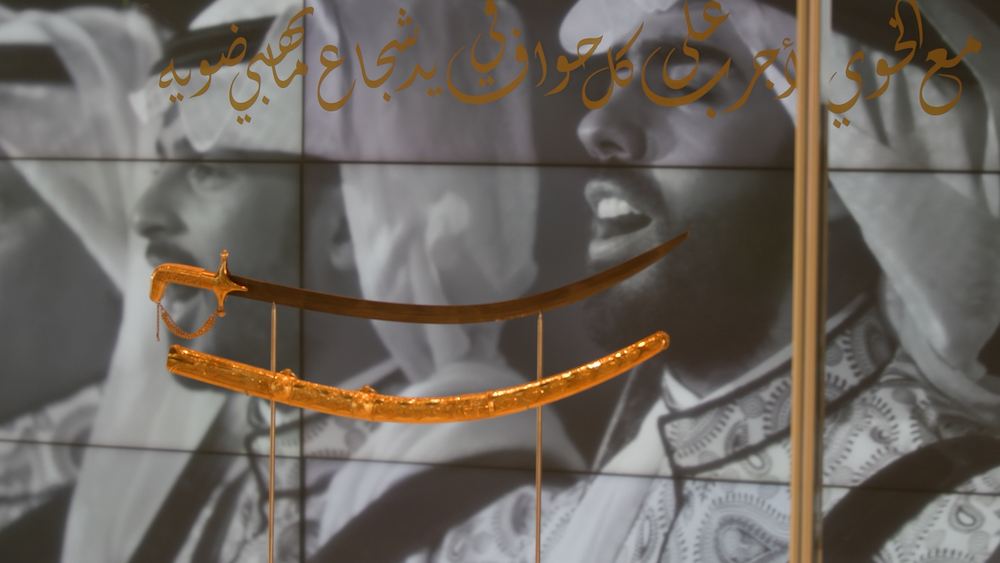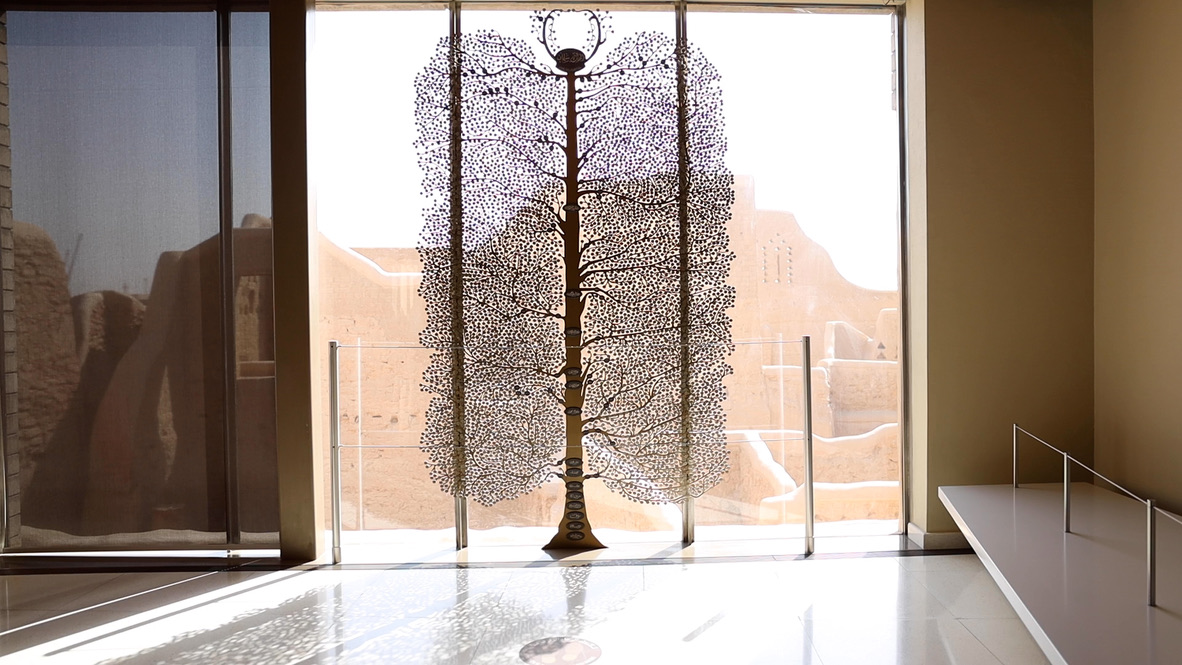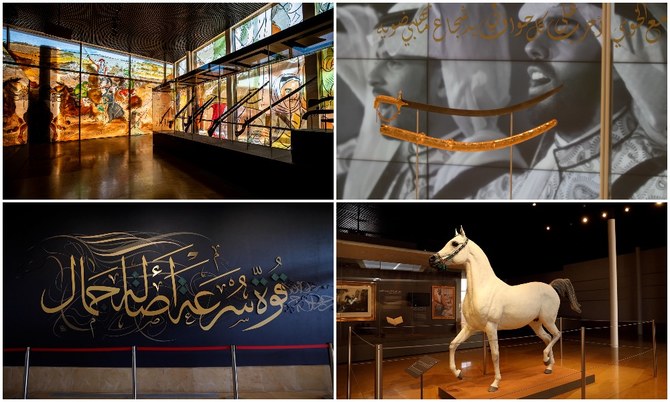RIYADH: At-Turaif is home to the largest open-air museum in the world. Arab News visited five galleries in the district that take visitors back in time through the birth of the Kingdom, detailing every important aspect, including lifestyle, trade, territory disputes and architecture of the Saudi states.
1 - Diriyah Museum:
Diriyah Museum is known for taking individuals step by step into a sequence of historical events dating back to the formation of the Saudi states.
The museum begins in A.D. 400, displaying maps and documents pertaining to the Banu Hanifah tribe migration from the west Arabian Peninsula to the center of Al-Yamama.
It explains how Diriyah was established in 1446 when Manaa’ Al-Muraide shared the region’s leadership with his cousin Ibn Dera’.

The Diriyah Museum holds replicas of some of the most important documents that contributed to the growth of the first and second Saudi states. (Abdullah AlJabr)
On display are swords, coins, stamps and copies of important documents that contributed to the growth of the first and second Saudi states.

Housed in the Diriyah Museum is a replica of the Al-Ajrab Sword owned by the founder of the second Saudi state, Imam Turki ibn Abdullah. (Faisal AlDakheel)
The museum also showcases the progression of the Al-Saud royal family tree throughout each century. A digital and interactive activity allows visitors and their families to swipe through the royal tree and learn about unity, stability and the reform of the region dating back to the establishment of the first Saudi state by Imam Mohammed ibn Saud in 1744.
The tree explains the royal lineage, further detailing Imam Turki ibn Abdullah’s eviction of the Ottoman garrisons from Najd, the founding of the second Saudi state and the return of King Abdulaziz ibn Abdulrahman Al-Faisal to the Kingdom of Saudi Arabia.

The Al-Saud family tree can be seen in the Diriyah Museum detailing the names of the sons, daughters, and grandchildren of King Abdulaziz. (Supplied)
One of the most prominent features of the museum is a replica of the Al-Ajrab Sword owned by the founder of the second Saudi state, Imam Turki ibn Abdullah. The sword is named after the rusting on the edges of the blade.
2 - The Arabian Horse Museum:
The Arabian Horse Museum gives an in-depth look into the vital roles horses played in the Kingdom’s unification in 1932, including in warfare, trade and transportation.
The museum houses many replicas of important documents that detail the names of thousands of horses owned by the Al-Saud family at that time.

The Arabian Horse Museum displays replicas of the different types of saddles, clothing, and important documents relating to the Kingdom’s unification in 1932. (Abdullah AlJabr)
The nobleman and sheiks of the era divided their horses into five categories:
Kehilan- Named for the black rings around its eyes resembling (Kohl) eyeliner.
Al-Hamdani- Named by its owners to distinguish it from the Kehilan horse.
Al-Saqlawi- Named for its glossy coat, the horse is known for its long neck and sparkling eyes.
Abayan- According to a legend, the rider’s coat, an abaya, slipped down to the horse’s tail during the race. Throughout the race the horse’s tail was raised, preventing the cloak from falling.
Hadban- One of the strongest and fastest horses, its name means “long forelock” (the top of the horse’s mane).

The Arabian Horse Museum also houses a life size bronze sculpture of a horse named Tarfah, a beloved horse King Abdulaziz gifted to King George VI of England. (Abdullah AlJabr)
Within the museum is a life-size bronze sculpture of Tarfah, King Abdulaziz’s horse which he gifted to King George VI of the United Kingdom.
The museum shows how domestication and taming of the horses was used as a vital part of eventual transportation and battle. On display are replicas of different types of saddles and clothing, based on the individual’s social status or occasion, such as weddings.
Copies of detailed travel documents for the horses are on display, including horses visas and passports in French and English.
The museum reflects how connected Saudi rulers were to their horses, treating them as loyal companions rather than just animals.
3 - Museum of Traditional Architecture:
The museum focuses on the first Saudi state’s architectural development and the present-day role of preserving the local UNESCO World Heritage Site.
The museum displays replicas of the buildings and techniques used to build structures, from foundations, plastering to decoration.
Visitors can read about the construction process of the walls of Saad Palace. The interior walls were usually 40 centimeters to 60 centimeters thick and the exterior walls were 120 centimeters thick. Once the walls reached the ceiling height, then doorways, stairways and ceilings began to be built.

The Museum of Traditional Architecture takes visitors step by step into the construction process of the walls of Saad Palace. (Abdullah AlJabr)
This is where visitors can notice the building detailing, such as entryways that were equipped with small sight holes for surveillance, or crenelations to provide aim and shelter during battle.
On display are audio-visuals displays and images that show the original process of creating each of the mud bricks and mud layers to form the foundation of the structures.
The museum also has many interactive features and games that allow visitors to test their knowledge in creating a traditional Najdi door. Once the doors are created, they are projected on a large screen to be displayed.
4 - Military Museum:
Diriyah was home to one of the largest firearms markets in the region. The military museum displays authentic replicas of all the weapons used during the second and the first Saudi state, including arrows, guns, cannons and ships.
It also shows foreign armors and shields, and the different types of ships that carried weapons cargoes at the time, including British and Saudi war ships.
Some of the rifle models on display include muzzle-loading muskets, breech-loading single-shot rifles, chassepots, Mausers and Martini-Henry rifles.

The military museum is home to replicas of all the weapons used during the second and the first Saudi state. (Supplied)
The museum also details the Battle of Diriyah, in which Ibrahim Pasha and the Ottoman army reached the city in 1818.
It also displays the Diriyah fortifications which were overseen by Imam Abdullah ibn Saud.
5 - Lifestyle Museum:
Village homes were simple and linked to the local environment. The Lifestyle Museum is a walk-through gallery that displays courtyards, bedrooms, kitchens, majlis and guest rooms in At-Turaif.
The Lifestyle Museum begins with the majlis, which feature motion sensors that cue audio of men socializing, tea being poured and items being cooked over a traditional fire oven.
Then visitors will see a traditional kitchen with a digital gallery of recipes used at the time.
The bedrooms in the homes were austere, but the detailing on fixtures indicated a resident’s status or wealth.
To avoid the heat, families would often sleep on the cool open roof and retreat to their bedrooms after sunrise, depending on the season.
The museum ends in the children’s room, where simple toys made of wood and straw are spread across the ground, while audio of children laughing and singing plays over the speakers.
The Lifestyle Museum perfectly captures the living style at the time in At-Turaif. It allows visitors to place themselves in the shoes of those before them, gaining a better understanding of how the Kingdom was born.





























